
by EDWARD J. GATELY, JR.
INTEGRATED circuits have not found wide application in audio circuitry to date, although they are in the process of revolutionizing the digital computer industry. Because of the size of the computer industry, IC manufactures have concentrated their efforts on developing digital IC's rather than units suitable for audio use. Some audio units have been made available, but until recently their cost has made them too expensive for all but the most exotic applications.
==========
NOTES
While the author describes the 709 series of IC's in the DIP-14 (dual in line plastic) package, they are also available in the 8-lead TO-5 type package, which some may prefer. For their information, the pin numbers of both types are shown in the diagram below, and the corresponding numbers are shown in the table.
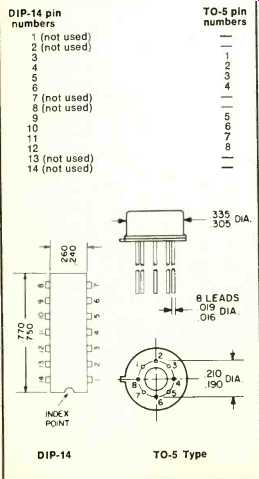
==========
To be suitable for audio use an IC must:
1) Have a cost under $2.00 in 100 quantities.
2) Have an output voltage swing of 10 volts rms.
3) Have an input noise comparable to presently available low-noise transistors--at least--125 dBm when used as a microphone preamplifier.
4) Have a slew rate of 1.7 volts/ microsecond. Slew rate is a measure of a circuit's ability to follow large rapidly changing signals; a high value is required if the circuit is to deliver maximum output voltage at high frequencies.
5) Have a power output of at 0.5 watts when used as a 600-ohm line driver (+24 dbm).
6) Have a minimum open loop gain of at least 10,000 (80 dB) . A recent survey of the Integrated Circuit market indicates that the Fairchild 0.709, Motorola 709 series, and Signetics N5709 units meet all of the above requirements except numbers 4 and 5.
For most applications, the slew-rate limitation can be designed around and where appreciable power is required, it can be obtained by buffering the IC output with a complementary emitter-follower circuit.
The 709-series Integrated Circuits are operational amplifiers featuring a differential input operating from a plus and minus 18-volt bipolar power supply (or a 36-volt single-voltage power supply) . They will deliver 10 volts rms into a 10k-ohm load. When used as a microphone preamp their noise is consistently below -127 dBm; a performance equal to the best low-noise transistor circuitry.
When operated as a unity-gain amplifier their slew rate is 0.25 V/µsec which limits the pass band to 2.5 kHz at 10 volts output or 1.6 volts output at 20 kHz. However, when operated at a gain of 20 dB a full 10 volts output can be obtained at 10 kHz. Open-loop gain of these units is 45,000 or 93 dB. Since audio circuits rarely require a gain of more than 40 dB from a gain module, more than 30 dB is available for negative feedback. This, combined with the inherent linearity of IC devices, means that distortion is rarely above 0.1 percent at 10 volts output. When commercial temperature ranges (0° to 75°C ) and plastic packages are accepted, 709 series devices are available at $1.85 in hundred quantities, and $2.80 in single quantity orders.
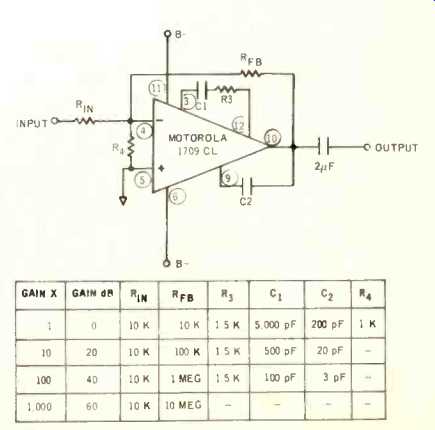
Fig. 1--Typical inverting amplifier.
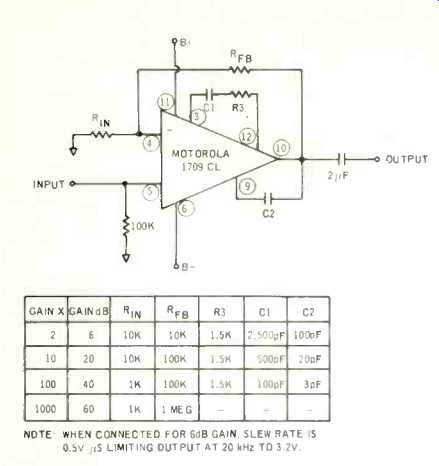
Fig. 2--Typical non-inverting amplifier.

Fig. 3--Microphone preamplifier.
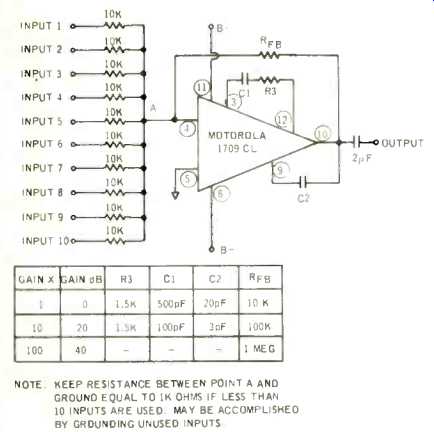
Fig. 4--Mixer-amplifier.
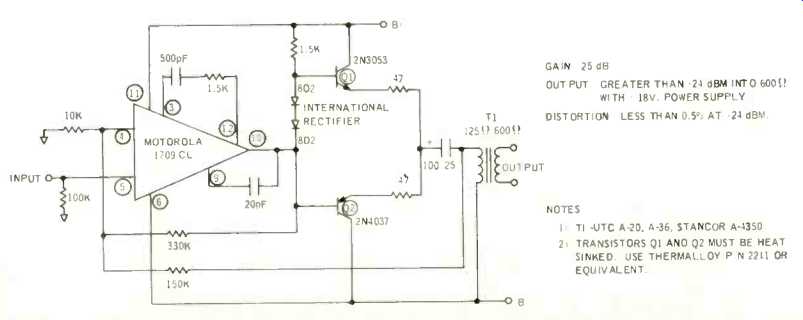
Fig. 5--Typical line amplifier.
Figures 1 through 10 show the application of one of these 709-series devices to the most commonly encountered audio circuits. The Motorola 1709CL was specifically chosen because of its wide availability at reasonable cost, and because of its 14-pin DIP package. This package is generally easier for the new IC experimenter to work with. It is recommended that all circuits be constructed using a 14-pin DIP IC socket.
Suitable ones are available from Barnes, Augat, Cinch, and others.
Within reason any bipolar power supply can be used up to 18 volts which is the design maximum for ICs. Exact bipolar balancing is not required; however if serious symmetrical clipping is to be avoided, the supply should be balanced within 10 per cent. For the beginning experimenter, it is recommended that diodes be placed in the positive supply line to guard against polarity reversals. One reversal usually destroys the IC permanently.
Because of the large amounts of feedback normally used with ICs, some means must be incorporated in the circuitry to ensure that they amplify rather than oscillate. This usually takes the form of compensation circuits. These are the small RC networks shown between pins 3-12 and 9-10 in the 14-pin package or between pins 1-8 and 5-6 in the 8-lead TO-5 package. Compensation values have been worked out for each of the circuits shown. No problems with parasitic oscillations should be encountered if the leads to and from the compensation capacitors are kept short and the output lead is not routed near the input leads. Recently several ICs have been introduced which do not require external compensation networks. To date these have been relatively expensive and have degraded slew rate specifications. It is hoped that these objections can be overcome in the near future so that IC circuit designers will no longer have to compute compensation values for every different application.
Operational amplifiers are normally supplied with a differential input stage.
One of the two inputs is labeled inverting and the second non-inverting. This means, if the inverting stage is grounded and a signal applied to the non-inverting input, the output signal will be in phase with the input signal. Conversely if the non-inverting input is grounded and a signal applied to the inverting input then the output will be out of phase with the input signal. For identification purposes the inverting input is labeled with a minus sign and the non-inverting input is labeled with plus sign.
Figure 1 shows the simplest possible IC audio amplifier. The gain of the circuit is the ratio of R_fb to R_in. Although other values could have been selected, R244 is shown as 10k ohms as this would have negligible loading on a previous IC stage and still be a value which would minimize thermal-noise generation. To avoid slew rate problems when operated as a unity-gain amplifier, R. attenuates the input signal by 20 dB and the amplifier then adds 20 dB of gain to make up for this loss. This attenuate amplify technique is not required at gains in excess of 20 dB. When signals are obtained from phono cartridges, tape heads, input transformers, and similar devices an input impedance of 10 k ohms would be too low.
Therefore the circuit shown in Fig. 2 must be used. This circuit utilizes the non-inverting input which has an input impedance of about a megohm. A resistor of 100k ohms has been shown between this input and ground as it is customary to have a ground-return path. A 1-meg value could have been shown just as well. The user is cautioned that when operated at gains below. 20 dB, voltage output capability of this circuit at high frequencies is limited by slew rate.
Figure 3 shows an application of the non-inverting amplifier to microphone preamp service. This 60-dB configuration will give plenty of gain when used with dynamic microphones. The 40-dB version is intended for use with high-output condenser microphones. Even with this reduced gain, preamplifier overload problems could occur when high-output microphones are used in extremely close miking situations. Under these circumstances a 30-dB or even 20-dB gain preamplifier circuit could have overload problems.
Multi-input mixers and consoles require a noise-free method of adding or combining many signals. When more than about six signals must be added, the loss through the mixing network necessary to avoid crosstalk and interaction leads to noise problems. If active mixing is employed these problems can be minimized. Active mixing is accomplished by use of an inverting amplifier and summing the signals at the input. A circuit for active mixing is shown in Fig. 4. The action of the feedback is such that in the unity-gain connection the apparent (virtual) resistance between point A and ground is about 100 ohms. This relatively low resistance limits thermal noise, crosstalk, and input-circuit interaction.
When 709-series ICs are called on to deliver power signals, they just are not up to the job. However, by using this IC as a driver amplifier for a complimentary pair of emitter followers, an excellent 0.5-watt amplifier can be designed. The circuit shown in Fig. 5 is an example of such a design. Note the use of a parallel feedback network. Such a network accomplishes the following:
1) The inner feedback loop around the IC itself assures d.c. stabilization of the circuit as well as reduces distortion.
2) The outer loop reduces any distortion in the output stage.
The output transformer is returned to the negative power lead to assure that the output electrolytic capacitor is voltage-stressed properly.
If an output transformer having an impedance ratio of 125:8 ohms were used in place of the one shown this amplifier would make a fine 0.5-watt speaker amplifier. For cueing or similar applications this amplifier would be ideal.
Phono pickup and tape-head amplifiers are similar to the non-inverting circuit shown in Fig. 2 except that the feedback loop contains the necessary reactive components to accomplish the required equalization. Typical circuits are shown in Figs. 6 and 7.
Equalization circuits for signal conditioning vary from simple tone-control circuits to elaborate peak-boost or-dip amplifiers. A typical tone-control stage is shown in Fig. 8. This circuit is 'adapted to the Motorola 1709CL from a circuit by Dick Crawford published in the November, 1969, issue of AUDIO. Most professional applications of equalizers require much-more-flexible equalizers than the common tone-control type. Figure 11 shows two peak-type boost curves and one peak-type dip curve which are typical of curves frequently encountered in professional applications. A peak boost of about 6 dB at 3 kHz will be used frequently to sharpen up dialog. When such equalization is used on a vocalist, the singer sounds as though he or she was 6 feet in front of the orchestra.
Peak boosting can be accomplished by using a series-resonant circuit in the feedback loop of an amplifier. Since circuits using audio-frequency chokes are subject to various ills, the LCR circuit is usually replaced with a bridged "T" network. The formulas for calculating the values of this network for various frequencies and notch depths are given on Fig. 9.
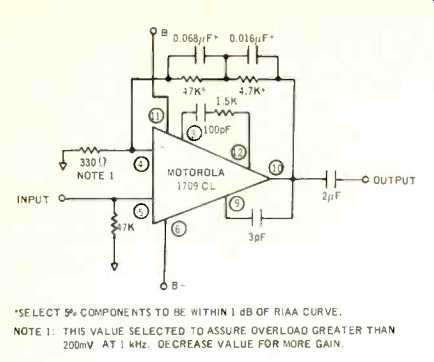
Fig. 6--Magnetic phono pickup amplifier.
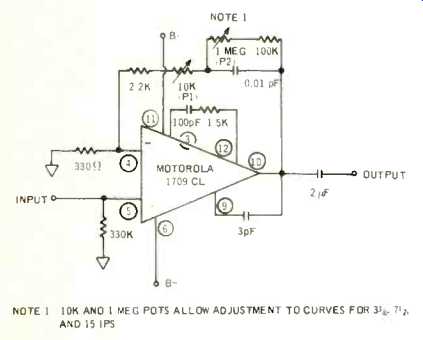
Fig. 7--Tape-head preamplifier.

Fig. 8--Typical tone-control stage.

Fig. 9--Peak-boost equalizer.
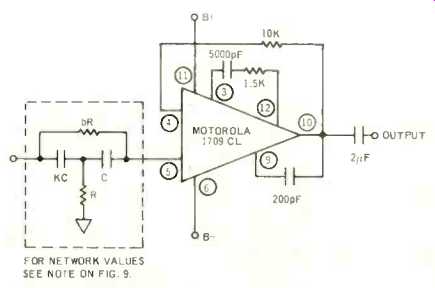
Fig. 10--Dip equalizer.
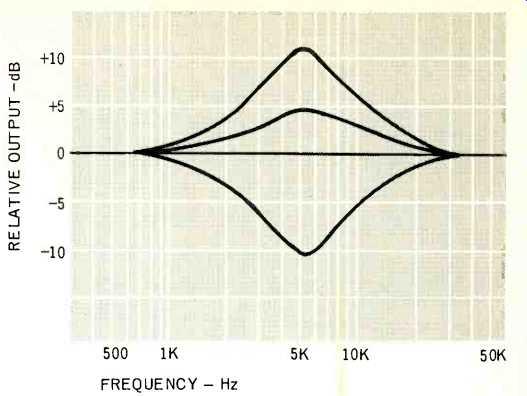
Fig. 11--Boost and curves obtainable with the circuits of Figs. 9 and 10.
To obtain dip-type curves, the same networks are inserted between the signal source and the non-inverting input of the amplifier. Professional program equalizers often provide equalization whose boost or cut can be stepped in 2-, 4-, 6-, or 12-dB steps. On the high end, peak frequencies may be selected at 1.5, 3, 5, 10, or 15 kHz At the low end of the spectrum additional peak frequencies of 40 and 100 Hz may be offered.
In this article we've shown all the common audio-signal-processing circuits adapted to IC circuitry. Integrated circuits are equally adaptable to the circuit requirements in other audio components such as tuners. Before many more years go by, all good audio equipment will be built around these new devices extensively. The next time you need a specialized circuit to solve a special requirement, why not use one of the IC circuits shown here? You'll be amazed at the simplicity of application compared with discrete-component circuits.
Suggested for further reading:
1) Ralph Gittleman "Applications of the Audio Operational Amplifier to Studio Use."-JAES
2) Dick Crawford "Build An Integrated Circuit Tone Control Stage." --AUDIO Nov. 1969
3) James N. Giles, Fairchild Semiconductor "Linear Integrated Circuits Applications Handbook."
(adapted from Audio magazine, Jun. 1970)
Also see:
Transistor Oscillators (Jun. 1970)
= = = =